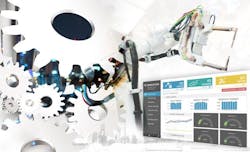To generate value from the Industrial Internet of Things (IIoT), companies will require analytics. But the same enterprise business rules don't apply in this new era of information in which data is collected at the machine or device levels and shared between different departments.
And, despite the business transformation opportunities that could result from the implementation of IIoT, many leadership teams are unclear about how to truly benefit from the technology. Or, how to incorporate new strategies and the skillsets that are essential to success in this shifting business model.
Understanding that many organizations need guidance when it comes to applying analytics to an environment in which more machines are producing data, the Industrial Internet Consortium (IIC) recently published the Industrial IoT Analytics Framework (IIAF) Technical Report. According to IIC, the free report is a first-of-its-kind blueprint for system architects and designers offering insight into how to map analytics to the IIoT applications they are supporting.
The main topics of IIAF include a framework overview providing a holistic view of the entire IIoT ecosystem, a business viewpoint on how to create business value, a usage viewpoint for getting started with industrial analytics, a functional viewpoint for analytic architecture and an implementation viewpoint for design considerations. It also covers artificial intelligence (AI) and Big Data, as well as analytic methods, modeling and system characteristics.
The document is purposely produced in a way that speaks to decision-makers, so that they can realize the potential of analytics to the overall business. But it is also valuable to technologists, engineers and architects looking to deploy IIoT systems. To that end, it shows system architects the steps involved in developing analytics for IIoT systems, including definitions and information flows that show how technologies can be applied to the applications.
“It is a structured way to think about the problem and gives different aspects to consider,” said Wael William Diab, IIC Industrial Analytics Task Group Chair, IIC steering committee member and senior director at Huawei. “It’s like the Kelley Blue Book for buying a car…It is providing a framework for how things are put together and different considerations.”
The framework does not prescribe or recommend the best technology or products, but presents different implementation approaches based on the business need. The functional viewpoint, for example, focuses on the functional components in an industrial analytics system. It looks at their structure and interrelations and the relation and interactions of the system with external elements to support the usages and activities of the overall system. The end-to-end IIoT system includes five functional domains: control, operations, information, application and business.
Then, the implementation view point deals with the technologies needed to implement functional components, such as their communication schemes and their lifecycle procedures. Major sections include design and capacity considerations as well as deployment models and data preprocessing, transformation and curation. Considerations such as scope, response time and reliability, bandwidth, capacity, security, volume, velocity, variety, analytics maturity, temporal correlation, provenance, compliance, etc., determine where the analytics run. And the framework introduces a table with these factors
One common question is where the analytics should be performed, on the edge or in the cloud.
“If you are trying to find insight about a machine on the floor and you are not interested in comparing it to anything else, then it can run at the edge,” Diab said. “Or if you need a really quick response time, that insight might affect safety of operations, so you run the stuff locally. But if there are no such constraints, it could run in the cloud.”
Ultimately, the document is a way to get IT and OT departments on the same page as it relates to how to think about using analytics so that the business as a whole generates the most important pieces of IIoT information.

